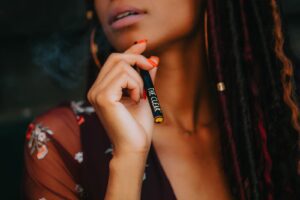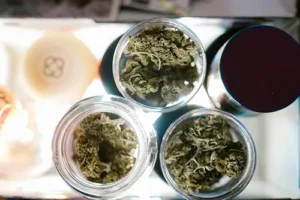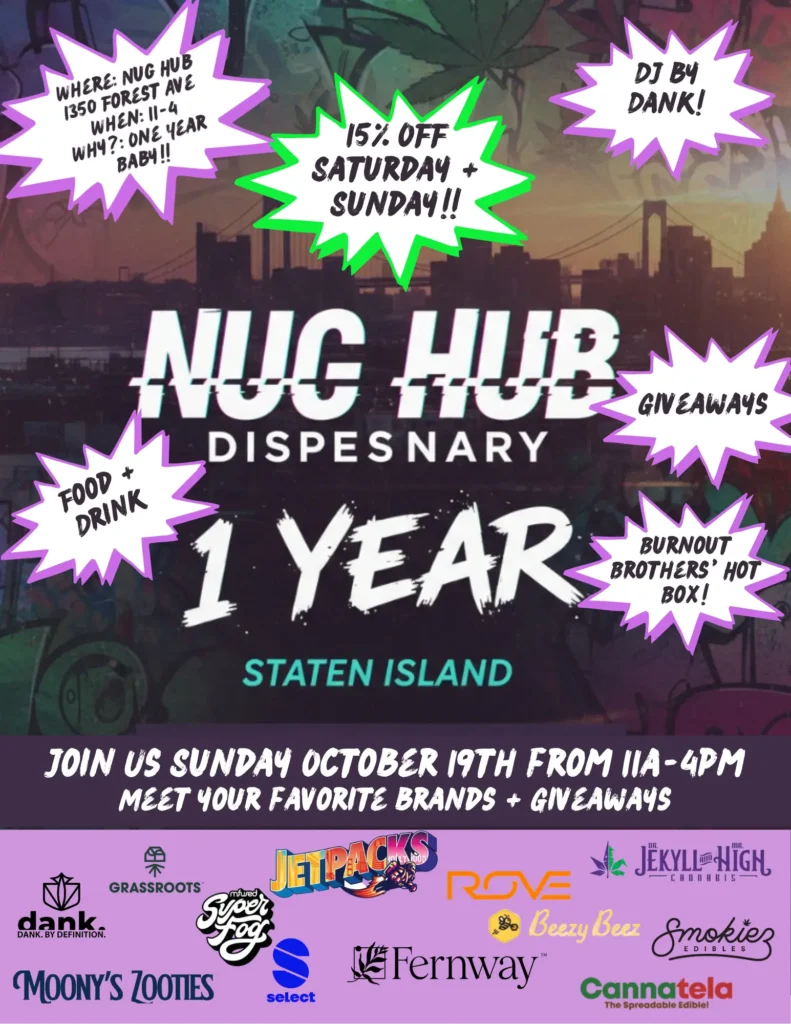Cannabis isn’t just about THC percentages or CBD ratios, its aroma carries real influence on how we perceive and enjoy the plant. Those distinctive scents, powered by terpenes and other natural compounds, shape not only flavor but also the overall character of the experience. In New York’s regulated market, where potency, labeling, and compliance matter, learning to appreciate cannabis aroma is more than a sensory exercise, it’s a smarter way to shop and consume responsibly.
Why does cannabis smell the way it does?
Short answer: chemistry. Cannabis aroma comes from a mix of naturally occurring compounds, primarily terpenes (like limonene, myrcene, pinene), plus smaller contributions from flavonoids, esters, and volatile sulfur compounds. Each cultivar (“strain”) expresses a different chemical fingerprint, which is why one jar smells like fresh lemons while another leans piney, herbal, or skunky. The exact mix influences how you perceive the experience and often correlates with flavor when inhaled or vaporized.
It’s worth remembering that terpenes aren’t unique to cannabis. They’re the same natural compounds that give fruits, vegetables, and herbs their signature aromas: limonene in citrus peel, pinene in rosemary and pine needles, linalool in lavender, and myrcene in mangos. Cannabis simply carries these familiar compounds in distinctive combinations that make each cultivar stand out.
Which terpenes show up most often, and what do they smell like?
- Limonene: bright citrus peel.
- Myrcene: ripe mango, earthy, herbal.
- Pinene (α/β): evergreen needles, rosemary.
- Caryophyllene: black pepper, warm spice.
- Linalool: lavender blossom, soft floral.
- Humulene: herbal, hoppy.
Terpenes don’t work in isolation; they’re part of a broader aroma matrix that includes minor terpenes and other volatiles. When you see a terpene breakdown on a product page or Certificate of Analysis (COA), it’s giving you a read on these contributors to scent and flavor. New York’s labeling and education resources encourage consumers to use lab information (including COAs) to understand what’s in a product beyond THC/CBD.
Does aroma change how cannabis feels?
Aroma doesn’t get you high by itself, THC does that, but the scent compounds can shape the character of your experience. Consumers commonly report that lemony or piney profiles feel more “bright,” while heavier herbal or floral profiles feel more “settled.”
That’s because cannabinoids (like THC and CBD) and terpenes often work together in what researchers call the “Entourage Effect“. This term describes how multiple cannabis compounds interact synergistically, creating effects that are greater, or at least more nuanced, than what each compound would produce alone. For example, limonene’s citrusy sharpness may enhance a sense of uplift, while myrcene’s earthy presence may contribute to relaxation, especially when paired with THC.
New York’s consumer guidance is clear: effects depend on potency, terpene combinations, and product form. Use aroma as a guide, not a guarantee, and recognize that the entourage effect is part of why two products with similar THC percentages can feel quite different.
How do different product forms treat aroma?
- Fresh flower & pre-rolls: Terpenes are more intact when flower is well-cured and stored properly. You’ll smell and taste the profile immediately.
- Vape cartridges: Live resin/rosin vapes preserve more native aroma; distillate vapes may add botanical terpenes for flavor. Expect clearer flavor notes than combustion.
- Concentrates (live resin, rosin, badder, hash): Higher terpene content often means fuller aroma, but these are potent and are best for experienced consumers. New York’s OCM specifically advises caution with concentrates due to strength.
- Edibles & beverages: Terpenes can be muted or transformed by cooking and formulation; flavor cues come from both cannabis and added ingredients. Edibles’ effects also arrive later and can feel stronger for many people.
What should new consumers ask themselves before choosing by scent?
- What do you want to feel? If you’re after something bright and daytime-friendly, start with citrus- or pine-leaning profiles. For evening wind-down, look for herbal, floral, or peppery notes.
- What method fits your plan? Quick onset (inhalables) vs. longer-lasting (edibles, capsules, tinctures). New York’s “Guide to Safer Cannabis Consumption” explains how methods differ so you can pick intentionally.
- What’s your tolerance? If you’re new, go low on THC, consider balanced THC:CBD items, and let terpene preferences steer within that low-dose range.
- What does the lab info say? Check potency, serving size, and, when available, terpene content or COA. Don’t rely solely on the name or color of the packaging.
How do you read New York cannabis labels without overthinking it?
New York requires clear labeling on adult-use products. A quick checklist:
- Potency: THC, CBD, and other cannabinoids, by percentage for inhalables and mg per serving/per package for edibles.
- Serving size: Especially critical for edibles to avoid accidental overconsumption.
- Warnings & instructions: Health and safety statements, storage notes, and use guidance.
- Batch/lot and testing: So you can match the product to its lab report (COA).
OCM’s “How to Read a Cannabis Product Label” and “How to Read a COA” resources show exactly where to find these items and how to interpret them. If terpene content is listed, it’ll appear in the same area as other testing info.
Are higher-THC products always “stronger,” aroma aside?
Not necessarily. Two reasons:
- Dose controls intensity: Ten milligrams of THC in an edible can feel very strong for a new consumer, regardless of terpenes.
- Method matters: Edibles metabolize through the liver and often feel stronger, later, and longer than inhaled products at the same nominal THC. New York’s “Know Your Edibles” guidance underscores slow onset and the risk of taking more before the first dose peaks.
Treat THC as the speed limit, not the destination. Let aroma help you choose the type of experience once you’ve selected an appropriate potency and product form.
What safety basics does New York expect you to follow?
- 21+ only for adult-use. Keep cannabis secured and out of reach of children and pets.
- Don’t drive or operate machinery when impaired, plan your ride.
- Start low, go slow, especially with edibles; wait to feel the full effect before dosing again.
- Buy from licensed retailers where products are tested, labeled, and traceable.
All of the above is directly reflected in OCM’s consumer and adult-use guidance, which is designed to help you consume more responsibly.
How do you verify a legal New York dispensary or delivery?
Use OCM’s official Dispensary Location Verification tool to confirm you’re shopping at a licensed dispensary, like NugHub NY. Licensed retailers sell lab-tested products made in New York, with compliant packaging, labeling, marketing, and advertising. If you prefer delivery, OCM publishes Adult-Use Cannabis Delivery FAQs that explain how licensed delivery works statewide.
How should you store aromatic products to keep them fresh?
- Keep it cool, dark, and airtight to slow terpene loss in flower.
- Leave products in child-resistant packaging until use; reseal after opening.
- Avoid heat in cars or sunny windows, terpenes volatilize easily.
- Lock it up if there are kids or pets at home.
These storage practices align with OCM’s emphasis on safe, responsible possession and packaging, protecting both aroma quality and household safety.
What’s a smart “aroma-first” shopping playbook?
- Pick a method that fits your plan today (quick vs. longer-lasting). Review OCM’s consumption guide if you’re unsure.
- Set your potency. For new consumers, choose low-THC items (or balanced THC:CBD).
- Shortlist by scent. Citrus/pine for brighter sessions; herbal/floral/spice for slower pacing.
- Confirm the label. Check THC/CBD per serving, serving count, and if available, terpene profile or COA.
- Plan the environment. Light snacks, water, comfortable setting. No driving.
- Reflect and iterate. Keep notes on what you liked about an aroma and how it mapped to your experience.
How do edibles and beverages fit into an aroma-driven approach?
You won’t smell them the way you do flower or vapes, but flavor still telegraphs the formulation. If you prefer cannabis that doesn’t smell like cannabis, look for beverages or chews where fruit, herbal tea, or spice flavors lead. Just remember: edibles can take up to two hours to fully take effect and may feel stronger for many consumers. Choose lower-dose servings, and don’t redose too soon.
What about concentrates: do terpenes make them a better aroma choice?
Concentrates can deliver spectacular, cultivar-true flavor, especially live resin and rosin, because they start from fresh or carefully handled material. But they’re also very potent. If your priority is taste and you’re still new, consider terpene-forward vape cartridges or low-THC infused pre-rolls before diving into dabs. New York’s OCM has specific consumer education urging caution with concentrates due to their strength.
What’s the most important line on the package?
For edibles: mg THC per serving. That line determines how quickly the experience can escalate if you forget to wait for onset. For inhalables: total THC/CBD and batch testing info. That tells you potency, and it lets you match the product to its COA to see deeper details, sometimes including terpene percentages. OCM’s label and COA guides show where to find all of this.
What expectations should you set as a new consumer?
- Aroma is a compass, not a promise.
- Potency and method set the intensity and timing.
- Setting matters, calmer environments tend to produce calmer experiences.
- Legal, labeled, and tested beats any mystery product, every time.
New York’s consumer resources exist to make those choices straightforward and safer.
Where does NugHub NY fit in?
NugHub NY maintains a curated menu across THC-dominant, CBD-rich, and balanced items, with options in flower, pre-rolls, vapes, edibles, beverages, and more, so you can shop by aroma, potency, and form in one place. If you prefer not to visit a store, NugHub NY also offers licensed delivery within its service area, consistent with New York’s adult-use delivery framework.
Final check against New York guidance
This article follows New York’s Office of Cannabis Management guidance on safer consumption and labeling: we avoid medical claims, emphasize 21+ use, stress label literacy, urge low-and-slow dosing (especially for edibles), reinforce no driving while impaired, and encourage shopping only at licensed retailers using OCM’s verification tools. See OCM’s consumer resources, label and COA guides, edibles education, and adult-use information for reference.
Ready to follow your nose?
If you’re new, choose a low-THC product in a scent family you naturally enjoy, read the label, and give the experience time to unfold. When you’re ready to explore, search NugHub NY’s THC and CBD products to find citrus-bright sativas, pine-fresh hybrids, or herbal-floral wind-down options that fit your plans today. Then refine your picks by potency, terpene profile, and form until you land on your perfect aromatic match.

